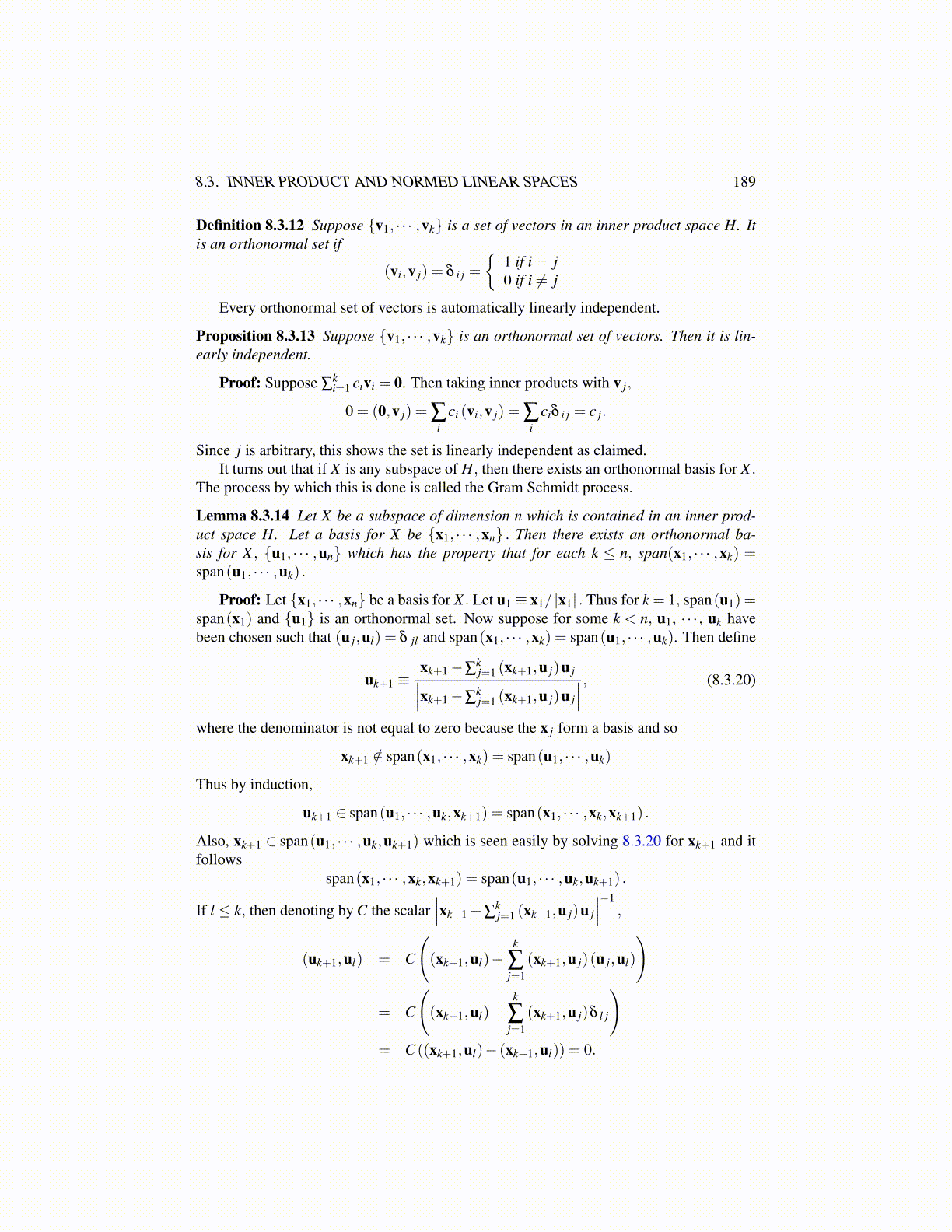
8.3. INNER PRODUCT AND NORMED LINEAR SPACES 189
Definition 8.3.12 Suppose {v1, · · · ,vk} is a set of vectors in an inner product space H. Itis an orthonormal set if
(vi,v j) = δ i j =
{1 if i = j0 if i ̸= j
Every orthonormal set of vectors is automatically linearly independent.
Proposition 8.3.13 Suppose {v1, · · · ,vk} is an orthonormal set of vectors. Then it is lin-early independent.
Proof: Suppose ∑ki=1 civi = 0. Then taking inner products with v j,
0 = (0,v j) = ∑i
ci (vi,v j) = ∑i
ciδ i j = c j.
Since j is arbitrary, this shows the set is linearly independent as claimed.It turns out that if X is any subspace of H, then there exists an orthonormal basis for X .
The process by which this is done is called the Gram Schmidt process.
Lemma 8.3.14 Let X be a subspace of dimension n which is contained in an inner prod-uct space H. Let a basis for X be {x1, · · · ,xn} . Then there exists an orthonormal ba-sis for X , {u1, · · · ,un} which has the property that for each k ≤ n, span(x1, · · · ,xk) =span(u1, · · · ,uk) .
Proof: Let {x1, · · · ,xn} be a basis for X . Let u1 ≡ x1/ |x1| . Thus for k = 1, span(u1) =span(x1) and {u1} is an orthonormal set. Now suppose for some k < n, u1, · · · , uk havebeen chosen such that (u j,ul) = δ jl and span(x1, · · · ,xk) = span(u1, · · · ,uk). Then define
uk+1 ≡xk+1−∑
kj=1 (xk+1,u j)u j∣∣∣xk+1−∑kj=1 (xk+1,u j)u j
∣∣∣ , (8.3.20)
where the denominator is not equal to zero because the x j form a basis and so
xk+1 /∈ span(x1, · · · ,xk) = span(u1, · · · ,uk)
Thus by induction,
uk+1 ∈ span(u1, · · · ,uk,xk+1) = span(x1, · · · ,xk,xk+1) .
Also, xk+1 ∈ span(u1, · · · ,uk,uk+1) which is seen easily by solving 8.3.20 for xk+1 and itfollows
span(x1, · · · ,xk,xk+1) = span(u1, · · · ,uk,uk+1) .
If l ≤ k, then denoting by C the scalar∣∣∣xk+1−∑
kj=1 (xk+1,u j)u j
∣∣∣−1,
(uk+1,ul) = C
((xk+1,ul)−
k
∑j=1
(xk+1,u j)(u j,ul)
)
= C
((xk+1,ul)−
k
∑j=1
(xk+1,u j)δ l j
)= C ((xk+1,ul)− (xk+1,ul)) = 0.